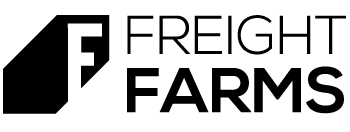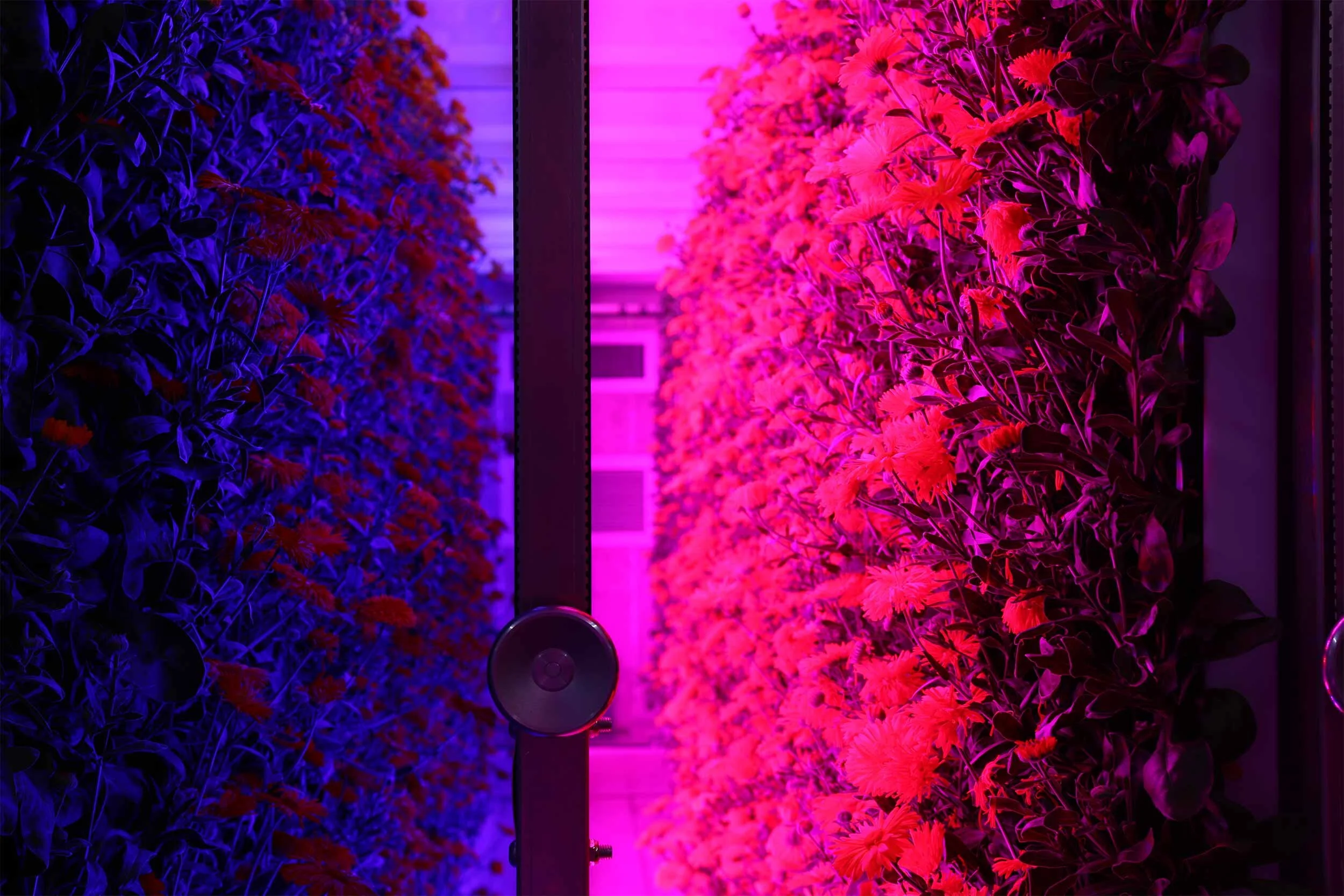Opening the Doors to the LGM: Webinar Recap
Hey there!
Since we wrote this article, we’ve built a completely new farm, the Greenery™. If you want to learn how this new farm operates, check out our webinar series about the tech and plant science that makes the Greenery the most advance container farm on the market today! Keep reading here if you’re interested in learning more about our previous farm, the Leafy Green Machine (LGM).
See how the Greenery compares when you download the Greenery booklet.
Learn Everything You Need to Get Growing
Are you interested in launching a Freight Farms project in your community? The Leafy Green Machine is a powerful tool for growing fresh produce 365 days a year. And we understand there is a lot to learn about the system before you decide to get growing yourself.
When people begin researching how to become a freight farmer, they ask dozens of questions about what kinds of crops they can grow in Leafy Green Machine, how much they can expect to grow on a weekly basis, how the climate automation works and more. That's why last week we held a webinar with Andrew McCue, Farm Systems Expert, and Jaime Silverstein, Crop Specialist, to help you gain a deeper understanding of the LGM. During the webinar we covered:
Shipping Container Farming (structure, design, insulation)
Climate Controlled Growing (temperature control, hydroponic growing, LED lighting, automation)
Crop Life-cycle (which crops grow best, crop scheduling and programing, growing space)
Labor & Support (weekly labor hours, in-person and web support)
Yields (weekly harvest data, production by crop)
Below find a recap from our live question and answer segment, or watch the full recording!
Webinar Q&A
Q: Is the Leafy Green Machine (LGM) able to function in 110 degree weather?
Andrew McCue (AM): Absolutely, we've seen temperatures as high as 130 degrees fahrenheit and as low as negative 50 with no interruption to growing. As long as you are able to supply water and electricity you can grow in extreme climates.
Q: What's the lead time after I order the LGM? And what are the setup charges?
AM: The lead time is six to eight weeks from signing to delivery on your site. As for set-up, most farmers opt to set up the farm themselves. You will also need to hire a plumber and electrician to get water and energy to the farm.
Q: Does the farm come with a warranty?
AM: Yes, the farm comes with a one-year end-to-end warranty. Repairs can be done by any specialist. The farm in and of itself is a new, and complicated product, but the individual components should be extremely familiar to any plumber, electrician or HVAC technician in your area.
Q: What is the lifespan of the LGM and how difficult is it to replace a light strip?
AM: About ten years, it should keep running for longer than that, but after you hit that ten-year mark you may need to do a little more maintenance. As for replacing the light strip, it's as easy as screwing in a light bulb.
Q: Does the bottom of the container ever rust?
AM: No, the containers are coated with a protective element to keep them safe from the weather outside.
Q: It was noted previously that there are 4,500 plant sites in the mature plant growth area, yet the projected weekly yields are much less than that, why is that?
Jaime Silverstein (JS): You will have plants at varying stages of crop development in the farm at any given time. In order to ensure a consistent weekly yield we divide the crop columns into sections, so you'll be seeding and harvesting and transplanting in each section once per week. The 4,500 plant sites are also based on a 17-18 plant spacing per column, but depending on the crops you grow, you may have some crops that are spaced ten plants per column, or some that are spaced 17-20 plants per column, it all depends on what you're growing.
Q: Do we have to buy all the supplies from Freight Farms and are the seeds GMO free?
JS: We sell all the supplies and consumables you need to operate the farm on our farmhand shop, but you can also purchase these products at any hydroponics stores. At our HQ farm we use Johnny Seeds, which are GMO-free, but there are a lot of great regional seed companies out there that you can source from.
Q: Can you give an example of the most successful leafy greens to grow?
JS: There are a lot of plants you can successfully grow. Outside of the lettuce category, I think mustard greens are really easy, as well a quick to grow. Kale and swiss chard are also super abundant growers, and are flexible in terms of what size leaf you want to harvest.
Q: Are the farms solar compatible and what kind of electricity use am I looking at from a daily standpoint? And what if there's an emergency and my electricity shuts off?
AM: The LGM uses on average 125 kW/H per day. It will use a little bit less in cooler, shady locations, and a little bit more in sunnier, warmer areas. The farm is absolutely solar-compatible, it just depends on whether the customer is able to pay for solar panels. Shaggy Bear Farms is currently our only farmer who is using solar, they had the right local incentives and tax breaks to make it a worthwhile option for them, but any farm could be hooked up to solar. If you lose power for any reason, the farm will keep your plants alive for about two days. If you're in a region where power outages are frequently, then we recommend installing a backup generator.
Q: If a sensor picks up that the temperature inside the farm is getting too hot will the system notify me?
Caroline Katsiroubas (CK): Yes, you get push notifications from your LGM through our farmhand mobile app. As the operator, you set the parameters for your farm. For example if you want your farm to stay between 62-67 degrees and the temperature exceeds that threshold, you are sent a notification and your system will automatically adjust the lights or AC system until the farm drops back into the appropriate threshold.
Q: What kind of programming and resources are available for future farmers?
CK: As this is a really new technology, we have to do a lot of educating and so do our farmers! If you're bringing this technology into a community where it's the first freight farm, you might need to approach your zoning administration for approval, and we have a zoning guide and other resources that customers can download right from our Case Studies page on our website, or talk to our team members. We also have guides to help you through finding financing and forming your business plan.
Q: How does growing multiple crops affect yields?
JS: Most leafy greens require the same climate and growing conditions, but herbs tend to have some different growing needs, especially when it comes to temperature. There are a large variety of cool-weather herbs that grow really well with lettuces, and then some warm-weather herbs like thyme and oregano will grow in the same conditions as leafy greens, but might just take a little longer. The one real exception to that rule is basil. Basil requires warm temperatures to grow, so it has a really hard time growing with lettuce, which thrives in cooler environments. So if you want to grow basil, we recommend dedicating your entire farm to growing basil and other warm-weather herbs.
Q: How are universities and schools using the Leafy Green Machine?
CK: There are so many innovative ways universities are using the LGM. Some have the food service team operate the farm with input from chefs to determine what to grow, others are student-run, providing experiential-learning opportunities for-credit. You can check out more examples on our education page.
Q: What kind of nutrients are used to grow in the farm?
JS: We use nutrients from companies established in the hydroponics industry. We prefer to use a liquid-based nutrient because of its compatibility with our dosing and irrigation system. Water soluble nutrients won't clog up our system, and will easily deliver the nutrients your crops need to thrive.
Q: Do you ship the LGM overseas?
AM: Yes, we are CSC and ISO certified. We are currently in a few Atlantic and Pacific islands, as well as Canada, the US, the EU, and Dubai. These are our current markets, we are looking at very targeted international expansion because we want to make sure that we can support Freight Farmers wherever they are. We are looking to continuing expanding our reach though, so if you are in a region we don't yet serve, make sure to sign up for our newsletter to stay up to date with the latest Freight Farms news.












